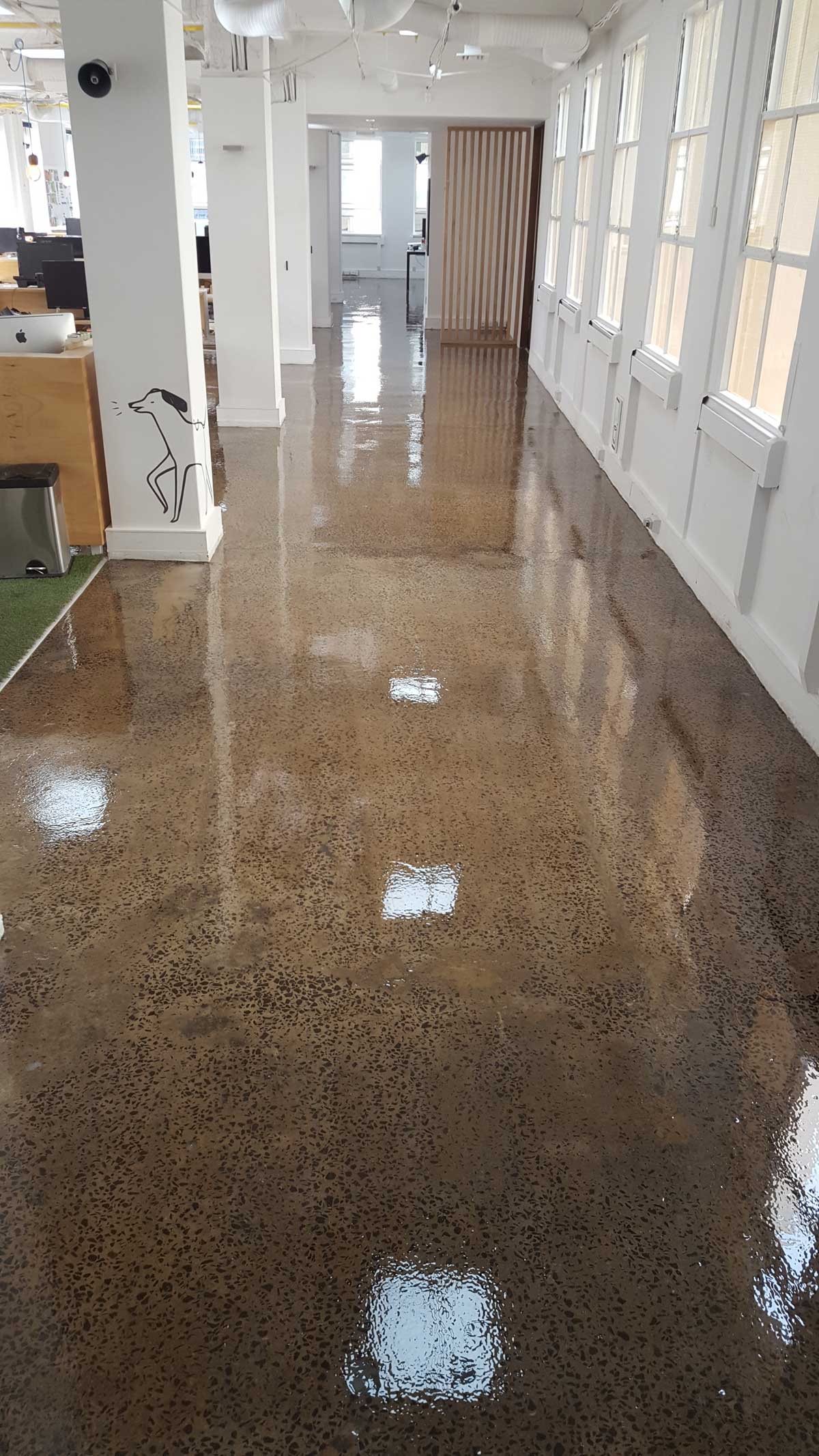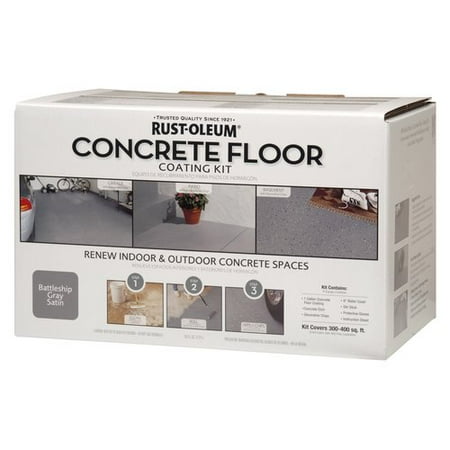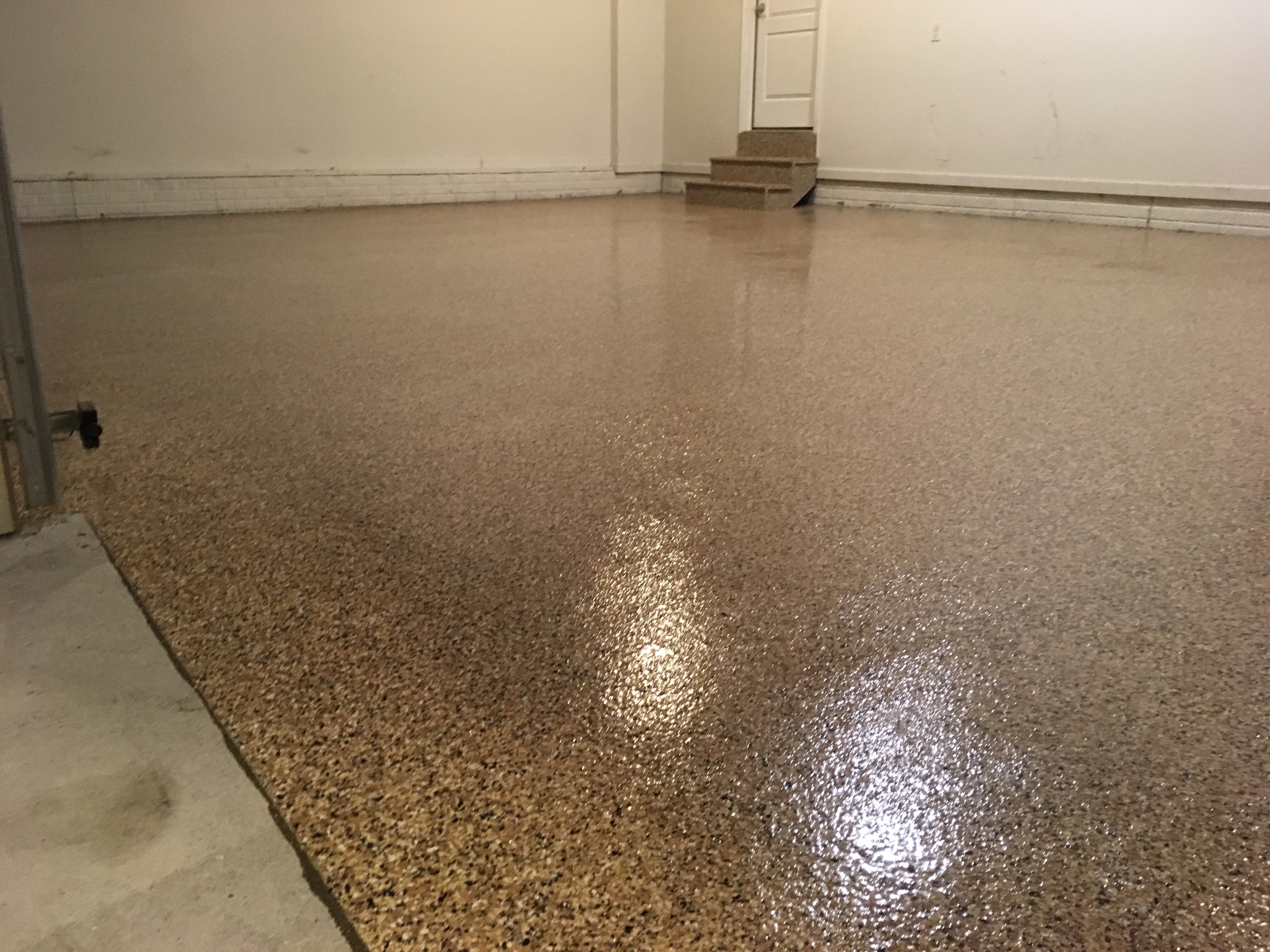Concrete Floor Coatings Overview
Concrete floor coatings are essential for enhancing the durability, appearance, and functionality of concrete floors in both residential and commercial settings. These coatings provide a protective layer that shields the concrete from damage due to heavy traffic, chemicals, moisture, and other environmental factors. Beyond protection, concrete floor coatings can significantly improve the aesthetic appeal of a space, offering a variety of colors, finishes, and textures.
Choosing the right concrete floor coating involves understanding the specific needs of the environment where it will be applied. Factors such as the level of foot or vehicle traffic, exposure to chemicals, and desired appearance must be considered. The right coating can transform a plain concrete floor into a stylish and functional surface that meets the specific demands of the space.
Concrete floor coatings come in various types, each with its unique properties and advantages. Epoxy, polyurethane, and polyaspartic coatings are among the most popular options. Epoxy coatings are known for their excellent adhesion, durability, and resistance to chemicals, making them suitable for industrial and commercial applications. Polyurethane coatings offer superior resistance to abrasion and UV rays, making them ideal for outdoor applications. Polyaspartic coatings, on the other hand, provide rapid curing times and can be applied in a wide range of temperatures.
The application process for concrete floor coatings is crucial for achieving the desired results. Proper surface preparation is key, involving cleaning, repairing cracks, and ensuring the concrete is dry and free of contaminants. The application method can vary depending on the type of coating, with options including roller, brush, and spray application. Each method requires specific techniques and tools to ensure an even and effective coating.
In addition to protection and aesthetics, concrete floor coatings offer several other benefits. They can improve the safety of a space by providing slip-resistant surfaces, reduce maintenance costs by making floors easier to clean, and extend the lifespan of the concrete by preventing wear and tear. These coatings can also enhance the energy efficiency of a building by reflecting light and reducing the need for artificial lighting.
Overall, concrete floor coatings are a valuable investment for any property owner looking to enhance the durability, appearance, and functionality of their concrete floors. By choosing the right type of coating and ensuring proper application, you can achieve a surface that meets your specific needs and provides long-lasting benefits.

Types of Concrete Floor Coatings
Concrete floor coatings come in a variety of types, each suited for different applications and offering unique benefits. Understanding the characteristics of each type can help you choose the best option for your specific needs.
Epoxy Coatings: Epoxy coatings are among the most popular choices for concrete floors due to their exceptional durability, chemical resistance, and adhesive properties. They consist of a two-part system that includes a resin and a hardener, which, when mixed, form a rigid plastic material. Epoxy coatings are ideal for high-traffic areas such as garages, warehouses, and industrial facilities. They can withstand heavy loads and resist damage from chemicals, making them suitable for environments where spills are common. Additionally, epoxy coatings come in a wide range of colors and finishes, allowing for customization to match the aesthetics of the space.
Polyurethane Coatings: Polyurethane coatings are known for their superior resistance to abrasion and UV rays. This makes them an excellent choice for outdoor applications and areas exposed to sunlight. Polyurethane coatings are also more flexible than epoxy, allowing them to better absorb impacts and reduce the risk of cracking. They are often used in commercial settings, such as shopping malls and hospitals, where durability and ease of maintenance are important. Polyurethane coatings can be applied over epoxy coatings to enhance their durability and UV resistance.
Polyaspartic Coatings: Polyaspartic coatings are a type of polyurea, known for their rapid curing times and ability to be applied in a wide range of temperatures. This makes them ideal for projects with tight deadlines or for application in environments where temperature control is challenging. Polyaspartic coatings provide excellent adhesion, durability, and chemical resistance, similar to epoxy coatings, but with the added benefit of faster curing. This allows for quicker turnaround times and reduces downtime for businesses. They are commonly used in commercial and industrial settings, as well as for residential garage floors.
Acrylic Coatings: Acrylic coatings are often used for decorative purposes due to their ability to create a glossy finish and enhance the color of the concrete. They provide moderate protection against UV rays and weathering, making them suitable for both indoor and outdoor applications. Acrylic coatings are relatively easy to apply and can be used as a topcoat over other types of coatings to enhance their appearance. However, they are not as durable as epoxy or polyurethane coatings and may require more frequent reapplication in high-traffic areas.
Urethane Cement Coatings: Urethane cement coatings are a hybrid system that combines the durability of urethane with the toughness of cement. These coatings are highly resistant to thermal shock, chemicals, and heavy impacts, making them ideal for harsh industrial environments such as food processing plants and pharmaceutical facilities. Urethane cement coatings can be applied in thick layers to create a seamless, highly durable surface that withstands extreme conditions. They are also resistant to moisture, making them suitable for areas where water and humidity are prevalent.
Metallic Coatings: Metallic coatings are a type of epoxy coating that includes metallic pigments to create a unique, reflective finish. These coatings are often used for decorative purposes in commercial and residential spaces, such as showrooms, restaurants, and high-end garages. Metallic coatings can create a variety of effects, including marbled, swirled, or iridescent patterns, adding a touch of luxury and sophistication to the floor. While they provide good durability and chemical resistance, their primary appeal lies in their aesthetic qualities.
Application Process of Concrete Floor Coatings
The application process of concrete floor coatings is a critical step in ensuring a durable, aesthetically pleasing, and long-lasting finish. Proper preparation and careful application are essential for achieving optimal results. Here’s a comprehensive overview of the application process for concrete floor coatings.
Surface Preparation: The first step in the application process is to prepare the concrete surface. This involves cleaning the floor thoroughly to remove any dirt, oil, grease, or other contaminants that could interfere with the adhesion of the coating. Pressure washing, degreasing, and scrubbing are common methods used to clean the surface. Any existing coatings or sealers must be removed using mechanical methods such as grinding or shot blasting. Once the surface is clean, it should be inspected for any cracks, holes, or imperfections that need to be repaired. Filling these defects with a suitable patching compound ensures a smooth and even surface for the coating.
Moisture Testing: Before applying the coating, it’s crucial to test the concrete for moisture content. Excess moisture in the concrete can lead to adhesion problems and cause the coating to peel or blister over time. Moisture tests, such as the calcium chloride test or relative humidity test, can determine if the concrete is dry enough for coating application. If high moisture levels are detected, a moisture barrier or vapor barrier primer may be necessary to prevent issues.
Priming: Applying a primer is an important step that enhances the adhesion of the coating to the concrete. Primers are designed to penetrate the concrete surface and create a strong bond with the topcoat. They also help to seal the concrete, reducing the risk of bubbles or pinholes forming in the coating. The type of primer used depends on the specific coating system being applied. For example, epoxy primers are commonly used for epoxy and polyaspartic coatings, while polyurethane primers are used for polyurethane coatings. The primer is typically applied using a roller or brush and allowed to cure according to the manufacturer’s instructions.
Mixing the Coating: Concrete floor coatings are often two-component systems that require mixing before application. This involves combining the resin and hardener components in the correct ratio to activate the chemical reaction that forms the final coating. Mixing should be done using a mechanical mixer to ensure a thorough and consistent blend. It’s important to follow the manufacturer’s guidelines for mixing times and ratios, as improper mixing can affect the performance and appearance of the coating.
Applying the Coating: The application method for concrete floor coatings can vary depending on the type of coating and the desired finish. Common methods include roller application, brush application, and spray application. For large areas, a roller or squeegee is often used to spread the coating evenly across the floor. Brushes are typically used for cutting in around edges and corners. Spray application is suitable for achieving a smooth, even finish and is often used for polyurethane and polyaspartic coatings. Multiple coats may be required to achieve the desired thickness and coverage, with each coat allowed to cure before applying the next.
Curing and Finishing: Once the final coat is applied, the coating needs time to cure and harden. The curing time can vary depending on the type of coating and environmental conditions such as temperature and humidity. It’s important to follow the manufacturer’s recommended curing times and avoid traffic or heavy use of the floor until the coating is fully cured. After curing, the floor may be polished or buffed to enhance its appearance and achieve the desired level of gloss or texture. For certain coatings, such as metallic epoxy, additional steps like sealing or waxing may be required to protect the finish and maintain its appearance.
Benefits of Concrete Floor Coatings
Concrete floor coatings offer numerous benefits that make them an attractive choice for both residential and commercial applications. These benefits extend beyond mere aesthetics, providing functional advantages that enhance the durability, safety, and maintenance of concrete floors.
Durability and Longevity: One of the primary benefits of concrete floor coatings is their ability to significantly enhance the durability and longevity of the concrete surface. Coatings such as epoxy, polyurethane, and polyaspartic create a protective barrier that shields the concrete from damage caused by heavy traffic, impacts, chemicals, and moisture. This protection prevents wear and tear, extending the lifespan of the floor and reducing the need for costly repairs or replacements.
Enhanced Aesthetics: Concrete floor coatings can dramatically improve the appearance of a space. With a wide range of colors, finishes, and textures available, coatings can be customized to match any design preference. From glossy and reflective surfaces to matte and textured finishes, the possibilities are endless. Decorative options like metallic coatings and custom patterns allow for unique and visually striking floors that enhance the overall aesthetic of the space.
Chemical and Stain Resistance: Concrete floor coatings provide excellent resistance to chemicals, oils, and stains. This makes them ideal for environments where spills and exposure to harsh substances are common, such as garages, industrial facilities, and commercial kitchens. The non-porous nature of coatings prevents liquids from penetrating the concrete, making cleanup easy and preventing staining and damage.
Improved Safety: Safety is a critical consideration in many environments, and concrete floor coatings can contribute to a safer space. Many coatings offer slip-resistant finishes that reduce the risk of slips and falls, particularly in areas that may be wet or oily. Additionally, coatings can improve visibility by reflecting light, which enhances the brightness of the space and reduces the need for additional lighting.
Ease of Maintenance: Maintaining a coated concrete floor is generally easier and more cost-effective than maintaining an uncoated concrete surface. The smooth, non-porous surface of a coating makes it resistant to dirt and debris, allowing for easy cleaning with basic maintenance routines. Regular sweeping, mopping, and occasional resealing (if required) are usually sufficient to keep the floor looking its best. This ease of maintenance reduces the time and effort required to keep the space clean and presentable.
Moisture Protection: Concrete is naturally porous and can absorb moisture, leading to issues such as mold, mildew, and damage from freeze-thaw cycles. Concrete floor coatings provide a moisture barrier that prevents water from penetrating the concrete, protecting it from these potential problems. This is especially important in environments prone to high humidity or frequent exposure to water, such as basements and bathrooms.
Common Mistakes to Avoid
When working with concrete floor coatings, certain mistakes can compromise the quality and durability of the final result. Being aware of these common pitfalls can help ensure a successful coating application that provides long-lasting benefits.
Improper Surface Preparation: One of the most critical steps in the coating process is surface preparation. Failing to thoroughly clean and prepare the concrete can lead to poor adhesion and coating failure. It’s essential to remove all dirt, oil, grease, and existing coatings, as well as repair any cracks or imperfections. Neglecting this step can result in bubbles, peeling, and other issues that compromise the coating’s effectiveness.
Ignoring Moisture Testing: Moisture is a common culprit in coating failures. Applying a coating to concrete with high moisture content can cause blistering, delamination, and other problems. Conducting moisture tests, such as the calcium chloride test or relative humidity test, is crucial to determine if the concrete is dry enough for coating. If high moisture levels are detected, appropriate measures, such as moisture barriers or vapor barrier primers, should be taken to prevent issues.
Incorrect Mixing Ratios: Concrete floor coatings often involve mixing two or more components, such as resin and hardener. It’s vital to follow the manufacturer’s instructions precisely and mix the components in the correct ratios. Incorrect mixing can lead to incomplete curing, resulting in a weak or tacky coating. Using mechanical mixers and adhering to recommended mixing times can help ensure a thorough and consistent blend.
Applying Coating in Inappropriate Conditions: Environmental conditions, such as temperature and humidity, can significantly impact the performance of concrete floor coatings. Applying coatings in extreme temperatures or high humidity can affect curing times and adhesion. It’s important to follow the manufacturer’s guidelines for optimal application conditions and avoid applying coatings in unsuitable environments.
Insufficient Coating Thickness: Applying a coating that is too thin can result in inadequate protection and durability. It’s essential to achieve the recommended coating thickness specified by the manufacturer. Multiple coats may be necessary to achieve the desired thickness and coverage. Using tools like mil gauges can help measure the coating thickness and ensure it meets the required specifications.
Neglecting Post-Application Care: Once the coating is applied, it’s important to allow sufficient curing time before subjecting the floor to traffic or heavy use. Premature use of the floor can damage the coating and affect its performance. Following the manufacturer’s recommended curing times and keeping the area free from traffic, dust, and debris during this period is crucial for achieving a strong and durable finish.
How long do concrete floor coatings last?
The lifespan of concrete floor coatings depends on several factors, including the type of coating, the quality of the application, and the level of traffic and usage. Generally, high-quality coatings such as epoxy and polyurethane can last 10-20 years or more with proper maintenance. Regular cleaning and prompt attention to any damage can extend the lifespan of the coating.
Can I apply concrete floor coatings myself, or should I hire a professional?
While it’s possible to apply concrete floor coatings yourself, hiring a professional is recommended for the best results. Professionals have the experience, tools, and knowledge to ensure proper surface preparation, mixing, and application. DIY applications may save money initially but can lead to issues if not done correctly, resulting in additional costs for repairs or reapplication.
Are concrete floor coatings safe for use in homes with pets and children?
Yes, concrete floor coatings are generally safe for use in homes with pets and children. Once fully cured, the coatings create a non-toxic and non-porous surface that is easy to clean and maintain. Slip-resistant additives can be included in the coating to improve safety. It’s important to ensure proper ventilation during the application and curing process to minimize exposure to fumes.
How do I maintain a concrete floor coating?
Maintaining a concrete floor coating involves regular cleaning and occasional resealing if required. Sweep or vacuum the floor regularly to remove dirt and debris. Mop with a mild detergent and water as needed, avoiding harsh chemicals that can damage the coating. For stubborn stains, use a soft brush and a suitable cleaner. Inspect the coating periodically for any signs of wear or damage and address them promptly to maintain the integrity of the coating.
Can concrete floor coatings be applied to new concrete?
Concrete floor coatings can be applied to new concrete, but it’s important to allow the concrete to cure fully before application. The curing process typically takes 28 days, during which the concrete reaches its full strength and moisture levels stabilize. Applying a coating to uncured concrete can lead to adhesion problems and coating failure. Conduct moisture tests to ensure the concrete is dry enough for coating application.
What are the cost factors involved in applying concrete floor coatings?
The cost of applying concrete floor coatings can vary depending on several factors, including the type of coating, the size of the area, surface preparation requirements, and labor costs. Epoxy and polyurethane coatings tend to be more expensive due to their durability and performance. Additional costs may include moisture barriers, primers, and any necessary repairs to the concrete. Hiring a professional will also add to the cost but can ensure a high-quality, long-lasting result. It’s important to obtain multiple quotes and consider the long-term benefits when budgeting for a concrete floor coating project.
Related Posts:
- Interior Concrete Floor Paint Ideas
- Concrete Floor Epoxy Crack Filler
- Concrete Floor Basement Ideas
- Painting Concrete Floor With Epoxy
- Outdoor Concrete Floor Paint Ideas
- Concrete Floor Painting Tips
- Outdoor Concrete Floor Finishes
- Non Slip Concrete Floor
- Concrete Floor Epoxy Coating
- Outdoor Concrete Floor Tiles






